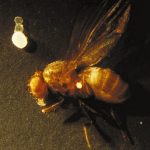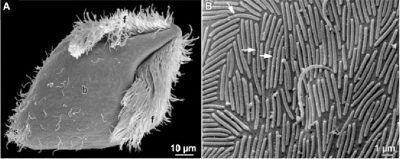The visible world is only a small part of Nature’s beauty. Below the resolution of the human eye, worlds exist that are inhabited by microscopic organisms called microbes. We can see objects that are about 0.04 millimeters (0.0016 or 1/615 inch) in size. The largest bacterium known, named Thiomargarita namibiensis, has been seen up to 0.75 mm, so is visible to the naked eye (see the photo below). Most bacteria, though, are only about 0.01 mm in size and, so, are invisible to us.

The worlds these microbes inhabit are nearly always watery. Microbes cannot live in dry air since they are so small that they would loose all the water in their cells rapidly in such conditions. This is the one condition that all life that we know requires: the availability of liquid water. I say “liquid water” because gas can exist as a gas and a solid, too, but in those forms its is not useful to life.
The water worlds of microbes can be much like our own in terms of temperature, saltiness, and corrosiveness. In fact, our bodies are home to many, many microbes, most of them helpful, or at least not harmful, to us. Some microbes, on the other hand, live in places that we could not live, in what we consider “extreme” environments. So, we call them extreme-loving organisms, or extremophiles. The suffix “philes” is from the greek word “philos,” meaning loving.
In this website I will talk mostly about two kinds of microbes, bacteria and archaea. I have a page on this site that describes what bacteria and archaea are, so you can go there to learn the definition of those two terms. There are other microbes that are larger and smaller than these. The generally larger ones have different kinds of cell structures, a structure like our own cells. Those organisms and us belong to a group called eukaryotes. Those kinds of cells contain their genetic instructions, in the form of DNA, inside an enclosed space called a nucleus. Bacteria and archaea, by contrast, do not have nuclei and their DNA is spread throughout their single cells. Viruses could also be considered microbes because they also cannot be seen without microscopes. They are generally smaller that bacterial and archaea cells. Some scientist do not consider viruses to be “alive,” since they do not “eat” anything to generate energy or synthesize anything (including more of themselves) as living organisms do.
I hope you enjoy your tours of these small worlds. I have included lots of links to other sources of information if you want to explore any of these places and their microbial inhabitants in more detail. I hope you come away as fascinated as I get when I consider these creatures. If you become aware of how important microbes are to our way of living, you begin to see your own world with new eyes. Your world begins to look different and you begin to see the connections between things in ways you might never have imagined. Welcome to your new worlds!
Bacteria & Archaea
You may have heard the word “bacteria” before, but do you know what it really means? Some people refer to them as “bugs,” but that is kind of insulting to both bacteria and bugs. Bugs are insects. Some people call them “germs.” OK, some of them are germs, meaning microbes that can make you ill. But hardly any bacteria make you ill, so that name is rather unfair, don’t you think? So what are bacteria, really?

Scientists use the word to refer to a kind of living organisms that are single-celled creatures. These cells can live singly, in pairs, in chains of cells, or in clusters of cells attached to one another. Our bodies are made of single cells, but our cells are much larger and more complicated inside. They are of a kind of cell called a eukaryotic cell that has its genetic material enclosed in a space separated from the rest of the inside of the cells and called a nucleus. Our cells all have specialized functions, too, and together make up a single organism. Bacterial cells are self-sufficient, for the most part. They do communicate with one another, using chemical signals, and some can move in a co-ordinated manner. By and large, though, each cell is on its own.
Bacterial cells have a rather simple organization inside. They each have genetic instructions that determine what cell components are made and when during their life cycle. These instructions are encoded on a large molecule called DNA (deoxyribonucleic acid). This molecule makes up the chromosome of the cell and it takes up a large portion of the volume inside a bacterial cell. Some kinds of bacteria have other smaller structures inside that serve specialized functions like absorbing light or storing energy sources (food) or enclosing spaces to carry out special processes or even tiny magnets to help those cells detect up and down.

Archaea are like bacteria in that their DNA is also not enclosed within a nucleus in their cells. Microscopically, they look very much like bacteria. However, it was discovered in the late 1970s that they are no more related to bacteria than they are to the families of organisms that have eukaryotic cells. Some of the archaea can grow in some of the most extreme conditions that we know supports life. However, others grow in the oceans, in soils, and even in human bodies, so they are not all extremophiles.